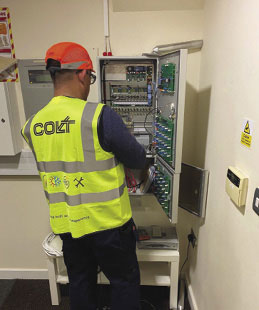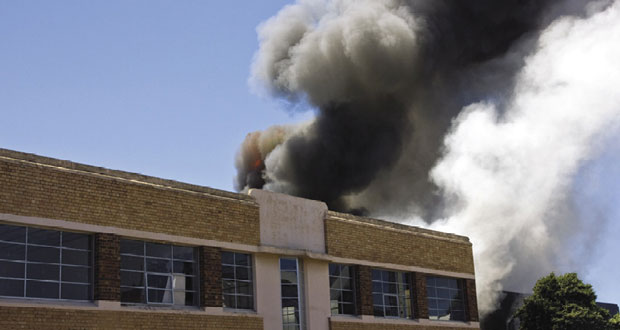Smoke is different to fire says Conor Logan, Colt’s Technical Director, which is why a properly maintained smoke control system is vital to help protect people, businesses and buildings
Smoke control systems are designed to protect escape routes for occupants to evacuate safely and unimpeded by the effects of smoke; assist fire fighters entering the building to find and tackle the fire quickly; protect stock and machines and loss of production capacity; and reduce risk of explosions and roof collapse.
It is important to understand the distinction between smoke clearance and smoke control. Smoke clearance uses a notional amount of ventilation to assist the firefighting operations, allowing firefighters to clear smoke from the relevant building or part of the building, often after a fire has been extinguished. Therefore, smoke clearance offers a limited benefit during the actual event of a fire or the building evacuation and as a result, smoke clearance has a much more simplified design process.
Smoke control, on the other hand, is designed to help during the actual event of a fire. It is designed to remove and restrict the movement of smoke while the fire is still burning, thereby assisting occupants with a safe escape. It primarily does this by extending the amount of time that a building’s occupants have to safely evacuate, without being overcome by the effects of the smoke.
In order to do this effectively, it is usually necessary to estimate the amount of smoke that will be produced, and how much heat will be generated. Therefore, smoke control system design requires careful consideration and expert maintenance.
TYPES OF SMOKE CONTROL SYSTEMS
Natural extraction systems:
- Have fail safe operation
- Are self-compensating
- Operate silently
- Have no time or temperature limits
- Are lightweight
- Are sensitive to wind effects
Mechanical extraction systems:
- Are not wind-pressure sensitive
- Are suitable for ducting
- Have a fixed extract volume
- Require noise and weight considerations associated with them
- Have a dedicated air inlet
- Have a standby unit in case of fan failure
Natural ventilation has the benefit of not requiring any power or any other functionality to work, (apart from the vents being open) as the smoke just escapes under its own buoyancy. They also have the added benefit of being ‘self-compensating’, meaning the hotter the smoke gets, the more effective the ventilators work, due to the increase in smoke buoyance caused by the heat. Mechanical systems extract at one rate only, so regardless of the amount of smoke, it will be extracted at a steady pace. Mechanical systems are also designed to extract smoke at a certain temperature for a set amount of time, e.g. 300 degrees Celsius for one hour. With natural ventilation, these constraints do not apply.
Mechanical systems have the benefit of not being sensitive to wind effects, as natural ventilators are. Plus, mechanical ventilators can be ducted, which allows them to be used in multi-level buildings. It must be noted that because of the power-reliance that mechanical systems have, it is standard practice to provide fire-rated wiring for them, a standby power supply and a stand-by unit, in case of fan failure.
Common building types that need specialised smoke control systems designed and installed are:
- Large single storey buildings, such as factories and warehouses
- Shopping centres
- Multi-storey buildings – residential and otherwise
- Buildings with atria
- Car parks where gas and fume extraction are required
 As with many fire safety systems, the concepts of smoke clearance and smoke control are quite straightforward. However, as life-safety systems, they must be robust and comprehensive. The design and equipment must be specific to the building-type and the installation and maintenance of the equipment must also be carried out by a very competent team to ensure the systems work properly when required.
As with many fire safety systems, the concepts of smoke clearance and smoke control are quite straightforward. However, as life-safety systems, they must be robust and comprehensive. The design and equipment must be specific to the building-type and the installation and maintenance of the equipment must also be carried out by a very competent team to ensure the systems work properly when required.
SAFE MAINTENANCE
Smoke control systems are often looked after by fire security companies, who may sub-contract this to independent “AOV” or “smoke vent” operatives. But a maintenance provider who isn’t fully aware of the intricacies of maintaining smoke control systems may not know exactly what ‘warning signs’ to look out for or what tests to run to resolve them. All too often, a simple smoke test is deemed as enough evidence that a smoke control system is working properly for this very reason. However, if your service provider is not doing full motor resistance and load tests, then your system is not being tested to work at maximum duty, which is precisely when it does need to function properly. If they are not testing to the cause and effect, battery charge rates, etc., then you will not know if the system will function properly in the event of a fire.





